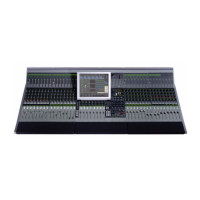Euphonix Max Air Mixing Console Operation Manual Channels and Strips
103
Focus Front (FocF): This parameter requires at least three speakers to function. Focus
ranges from 0–100%. At 100%, the signal has a pinpoint image: as the signal is panned,
it crossfades directly from one channel to the next, completely fading from the first be-
fore entering the third. As Focus decreases, the signal blurs across multiple channels:
the signal moves from channel one into two, and then begins crossfading into channel
three before channel one has completely faded out. This results in smoother, dynami-
cally panned objects across the sound field.
0% Focus eliminates the center channel from the pan range entirely. The pan control
still functions, although the signal crossfades directly from bus one to bus three. One
use of 0% Focus is to create phantom-centered images, where the signal is sourced
equally from the left and right front speakers instead of directly from the center speaker.
Divergence Front (DivF): This parameter requires at least three speakers to function.
Divergence ranges from 0–100%. At 100%, panning works as expected: Panned to
maximum left, there is no signal present in the right or center channels; at the center
position, no signal is present in the left or right channel, etc. As the Divergence is de-
creased, the degree of panning is decreased: The signal level increases in channels that
previously had no signal and the difference in signal level between channels decreases.
The purpose of Divergence is to allow someone listening on the extreme left or right to
hear a sound panned fully to the other side. For example, at 50% Divergence, a sound
panned fully left will retain approximately half its signal level in the right channel com-
pared to the left.
Non Boom Level (nonB): The level to all channels except the Boom channel. For ex-
ample, in 5.1-channel format, the Non-Boom level applies to L, C, R, Sl, Sr.
Divergence Surround (DivS): Same as Divergence Front.
Focus Surround (FocS): Same as Focus Front.
Divergence Rear (DivR): Same as Divergence Front.
Focus Rear (FocR): Same as Focus Front.
Width (Wdth): Available only on Multi Format Masters (see page 151). Controls the
front channel width.
SmartPan
The Max Air panner has an automatic function called SmartPan that prevents the dis-
appearance of the audio signal during panning if some of that Main Section’s busses are
not assigned. For example, if a channel is assigned to a 5.1 Main Section output but
does not send anything to the center Main bus, SmartPan automatically uses a stereo
pan law so the signal is still present when panned to the center. SmartPan is always on
and cannot be disabled by the user.

